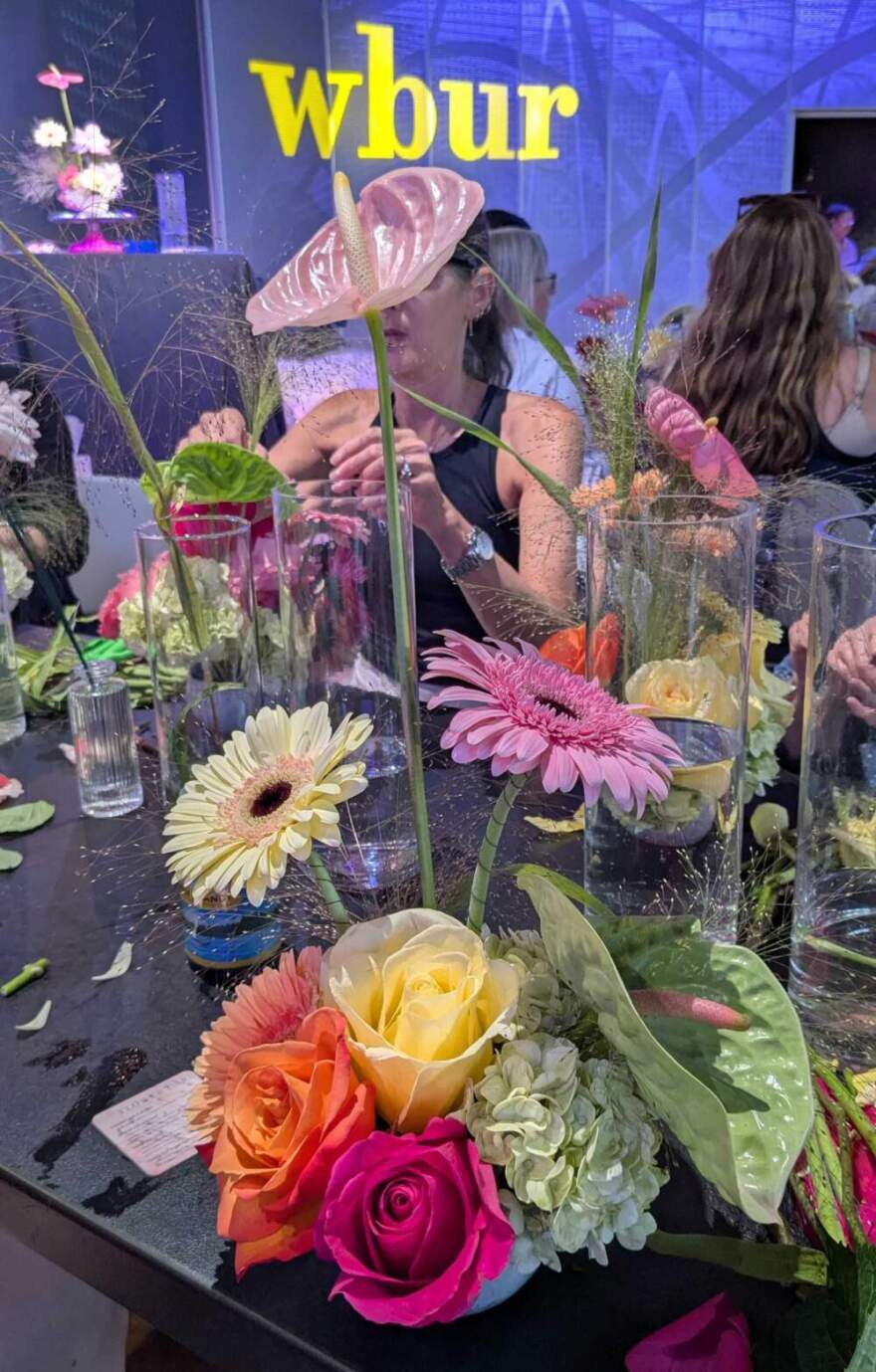Editor’s Note: This is an excerpt from WBUR’s Saturday morning newsletter, The Weekender. If you like what you read and want it in your inbox, sign up here.
Back in July, I was one of the lucky attendees of a sold-out CitySpace event. It was a flower arranging workshop with Claudia Lapena, co-founder of Somerville’s Rococo Floral Co. Surrounded by fragrant flowers, I was eager to learn. I got to work trimming stems and following along as Lapena showed us some of the tricks she’d picked up over 15 years in the trade. And I was pretty proud of the end result.
Rococo Floral is known for its eclectic arrangements. Lapena and her co-founder Julia Conrad say they like to “entertain themselves” by seeing what they can do with petals, stems, filler plants and more. The experimentation makes for some interesting visuals.
Autumn in New England offers a unique opportunity to create beautiful floral arrangements. According to Lapena and Conrad, locals can incorporate fall flowers, foliage and even yard clippings. Here are their tips:

What’s in season now
Dahlias and zinnias are the cream of the crop in New England right now, and if you can’t find them at the florist or the grocery store, many local farms will let you cut your own. Lapena and Conrad also suggest searching for celosia, lisianthus and “trendy” hay amaranthus, which are all in season right now.
Lapena said that locally grown sunflowers are also still “going strong,” at least until “the temperature turns.” So now’s the time to take advantage of the blossoms. Several local farms, including Tangerini’s Farm in Millis and Ward’s Berry Farm in Sharon, will let you pick your own.
And don’t just limit yourself to what’s available for sale. “ I’m in New Hampshire right now and there’s aster everywhere, which usually people think of as a weed,” Conrad said. “But it’s such a pretty lavender color, so that’s really pretty to cut.”
Arranging your stems
Once you’ve got your flowers, it’s time to build your arrangement. If you’re using a vase, Lapena says to insert a scrunched-up ball of florist’s wire into the bottom (before filling it with water) to keep your stems in place. (You can see how she does that here.)
Conrad recommends using discarded twigs with leaves to add a little autumn color and fullness to your arrangement. “Sometimes you’ll buy stems at the store and they’re a bit shorter, so you’ll wanna extend or fill out your base,” Conrad said.
Or, to add a “pop of whimsy,” Lapena suggests clipping some tall grass and placing a few bundles sparingly between your flowers. These bursts of grass add texture, “so it looks like something that you didn’t just make from grocery store flowers,” she said.
Playing with petals and stems
Conrad and Lapena pluck and bend their flowers to add visual interest to an arrangement. “It’s always fun to fully change the appearance of a flower,” Lapena said.
You can “reflex” or “fluff up” flowers like tulips or roses by gently bending the petals all the way back. (Click here to see Lapena demonstrate her “reflexing” method with a rose.) If you’re feeling experimental, you can also pull out the bundled petals at the center of a rose to expose its yellow, pollen-covered pistil. “That looks really cool, almost like a garden rose,” Lapena said.

Wrapping a bit of florist’s wire around a soft flower stem can help delay the effects of wilting. It also gives you a chance to bend the flower in any direction, like a pipe cleaner. (During the workshop, I used this tip to add a “Dr. Seuss” vibe to my arrangement.)
Even seasonal sunflowers, which are generally sturdy, can be manipulated. “There’s a big trend going on right now where people pull the petals off of sunflowers leaving just the pod,” Lapena said. “It looks … prehistoric, almost.”
Keeping your flowers fresh
If you want to help your final arrangement last long, Lapena says the best thing you can do is change the water.
“ If you wanna go the extra mile, you can always re-cut the stems,” she said. It’s also important to pull out stems as they die, since dead flowers contribute to molding in the water. You want a flower arrangement, “not a frog pond,” Conrad said.
For an arrangement that will last all season and beyond, consider drying your flowers first, said Conrad and Lapena. Strawflower and end-of-season hydrangeas dry beautifully, but the process takes about a week, according to Lapena.
Field Guide to Boston: Discover — and rediscover — your Boston.
How does it work? Lapena and Conrad will bundle their desired flowers with twine and hang them upside down to air-dry. Once they’re ready, you can put them in a vase or weather permanently in your home. (If you’d like to learn from, Rococo will be back at CitySpace on Dec. 1 — just in time for the holidays — with more on dried flowers and wreath making .
P.S. — WBUR's fall fundraiser kicked off this week. And with federal funding gone, we’re relying on readers like you. Nearly 175,000 people get newsletters from WBUR every week. We need 10,000 new Members to join our ranks this year to close the gap. Help us keep reporting the stories that inform, inspire and enrich your life by supporting WBUR today. (And for as little as $5 to $12 a month, you can get a WBUR hat or shirt.)
This article was originally published on WBUR.org.
Copyright 2025 WBUR







